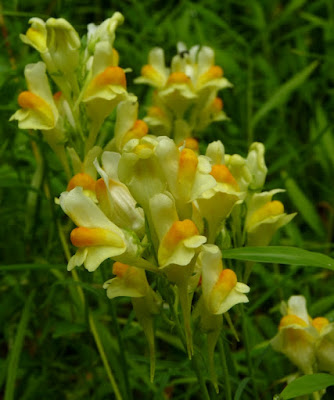In spring, Arrowwood bears bunches of small, white flowers. These flower bunches are attractive to many insects. I often saw bees and flies hovering around and nectaring at the flowers so that there was a constant hum of insect wings around the shrub. On some occasions I saw carpet beetles, like the ones in the photo above, foraging on the flower bunches. I think these may be Varied Carpet Beetles (Anthrenus verbasci). The beetles, in turn, were preyed on by ants.
As the summer progressed, the shrub dropped its flowers and the clusters started forming berries instead. Meanwhile, the toothed leaves themselves became food. I never discovered what was eating the leaves. According to a USDA fact sheet (pdf), Arrowwood may be vulnerable to the introduced Viburnum Leaf Beetle (Pyrrhalta viburni), which skeletionizes the leaves. In addition, Viburnum is a larval host plant for many species of Lepidoptera, including the Hummingbird Clearwing (Hemaris thysbe), Io Moth (Automeris io), Imperial Moth (Eacles imperialis), Cecropia Moth (Hyalophora cecropia), Gray Dagger (Acronicta grisea), and Baltimore Checkerspot (Euphydryas phaeton), to name a few.
As the berries ripen, they turn from light green to dark blue. I suspect that the fruits are the main reason for their inclusion in lists of wildlife-friendly plants since such recommendations tend to be targeted to birders. Arrowwood is an excellent food source for birds, in addition to the insects I have mentioned above.
The berries disappear from their stems very quickly, as birds find and eat them. They seem especially appealing to Gray Catbirds and American Robins, though other birds may also take advantage of them. In my area, the berries ripen in mid-August, which is a little too early for the bulk of songbird migration but just about right for hatch-year birds gaining independence and all songbirds fattening for their southbound migrations.












































